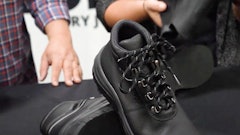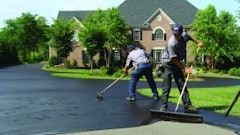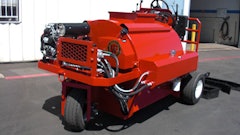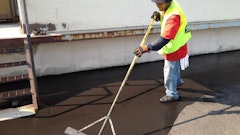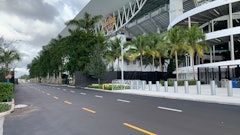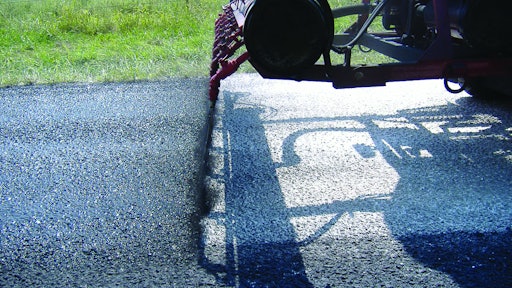
Sealcoating contractors make money by putting material on the ground. The more jobs you can complete the better your bottom line.
This leads to the question of how best to apply sealer. The East Coast market for sealcoating has always been a "spray" market while the West Coast has always been a "squeegee" market. Which is "right" depends on the material, the environment and the surface being treated.
But just because you are trying to put down more material faster doesn't mean you should put it down any less effectively. In fact, the profit motive does encourage some contractors to apply material in one pass when it should have been applied in two.
I am asked frequently about applying material in one heavy pass. Some of the equipment on the market today has the capability of spraying material this thick but is it the right thing to do? We have the responsibility of doing the right thing for our customers as they have to understand that the lowest bid is not always the company that will make the best decisions for the customer. Material applied too thick slows the cure time and has the possibility of coalescence cracking.
If the surface is smooth and has been sealcoated many times then it will be difficult to apply the proper thickness of sealcoating material using a squeegee. Spraying this type of surface will allow the operator to control the millage (thickness) of the mat. If the surface is coarse then spray might again be the best option because the voids in the surface could consume large quantities of material.
On moderate surfaces, those in between too smooth and too rough, a two-step process is often recommended where squeegee is the first application, forcing material into the voids, and spray is the second second application where we can leave an even mat and a more attractive surface.
Can an experienced operator with a squeegee machine apply material as fast as an equally experienced operator on a spray rig? Shear laws of mechanics would give the edge to the spray applicator, however we are not in a perfect world where all applications are straight with wide open areas. The truth is a blend of both types of application is the best answer.
Spraying can be a challenge and requires specific knowledge for trouble-free operation. What are the obstacles to successfully spray sealcoat? Clogged tips, an improper spray pattern (fan), slow application time, overspray and inconsistent coverage. If these issues are addressed properly spraying sealer can be a powerful tool in your pavement maintenance arsenal.
Pavement Preparation
Preparation is the key to a successful job. How do you prepare your edges for a spray application? Cutting-in the edges mechanically is fast, clean and will protect your gutters from overspray. This process can be faster with the right gear, so check with your equipment supplier for attachments such as spray shields or target distribution wands.
Filtration
The addition of aggregate into sealer has increased in large measure where contractors can effectively sealer -- but aggregate adds to the difficulty of application. Filtration is essential on a sealcoating spray system, and some systems feature pressurized. In a flitration system the filter’s orifice size should be the same size or smaller than the orifice on the spray tip. The concept is simple: If anything larger than the opening on the tip is stopped at the filter then anything making it to the spray tip should pass through.The filter should also be large enough to allow the operator to spray material for an entire day without having to stop for maintenance.
Spray Pattern
An improper spray pattern can be caused by several issues. The first thing to consider is the spray angle designation on the tip itself. Spray tipsa re available in a wide variety of configurations. Your choice of spray angle is dependent on two factors: the tip spacing on your spray bar and viscosity of the materia. Tips are calibrated with water so an 80/70 designated tip means an 80-degree spray angle with 7 gpm flow rate at a set pressure and the viscosity of water. All sealcaoting contractors have experienced firsthand the wide range of material viscosity in the field so each operator needs to test and know his own material. If you were to test an 80/70 spray tip with a gradual increase in viscosity you would see the actual spray pattern getting a little narrower with each increase. The opposite would be true with each reduction.
The second consideration affecting spray pattern is the pressure the material is under. When material is pushed through a fixed orifice (spray tip) at a reduced pressure the spray angle will be reduced proportionately. If the pressure is too high then the spray angle will be distorted and atomization of the material will occur, possibly causing overspray problems. The spray system needs to have a controlled, constant material pressure to maintain the spray angle. This also will address the inconsistent coverage issue too. (Every time the material pressure changes so does the flow out of the tip!)
Viscosity and Its Importance
Viscosity is the measurement of material thickness in its liquid form. The first benefit to measuring viscosity is to protect you and your supplier against a bad batch of product. It is not uncommon for anomalies to occur in the manufacturing process. Even the best suppliers can have occasional problems. If you cannot measure your product then how do you know it meets your high standards? As an applicator your reputation is on the line if the material fails to last. It's a smart practice to periodically check your equipment to ensure it is in good condition, why not do the same with your material? Measuring viscosity can be accomplished easily and inexpensively in the field with the right tools. Show the customer your commitment to exceptional professionalism!
The second benefit to knowing your viscosity is it helps you decide how to apply the material. Spraying material can be tricky; knowing the viscosity will help you determine the tip size, speed of the application, and the desired mat thickness. Once you know the viscosity setting up your machine for spraying is easy.
The spray tip is an orifice. Pushing a constant viscosity material through a fixed orifice requires a specific pressure and will produce a measured output. What the heck does that mean?
The pumping system should provide a consistent supply of material at a given pressure with the least amount of pressure ripple. If you want to apply material at a specific application rate you can very easily change your spray tip size.
Here is an example: Viscosity is approximately 44,440 centipoises, pump pressure is 22 psi, and tip size is 80/70. The flow out of each spray tip will be approximately 4.9 GPM. The nozzle spacing directly effects the application rate so factor that into your spread rate formula. Using desired rate, volume per nozzle, and overlap you can calculate the application speed of your equipment. There is equipment on the market today that can do the math for you.
At the end of the day you want to have supplied a quality job to your customer, have a project you can be proud to show your family and have a well earned profit in your pocket. Our industry is growing, our opportunities are expanding. Are you prepared to take advantage of these new opportunities?















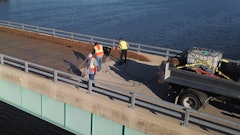




![Screen Shot 2023 01 04 At 5 23 30 Pm[35]](https://img.forconstructionpros.com/files/base/acbm/fcp/image/2023/01/Screen_Shot_2023_01_04_at_5.23.30_PM_35_.63bc42696de27.png?auto=format%2Ccompress&fit=crop&h=135&q=70&w=240)



